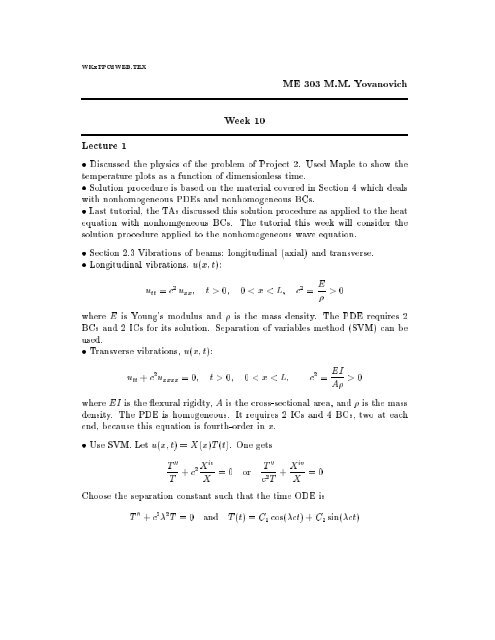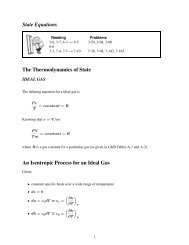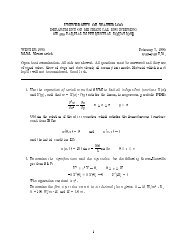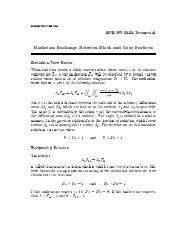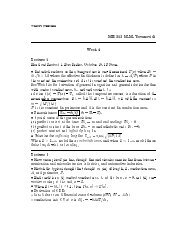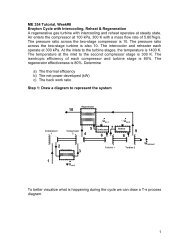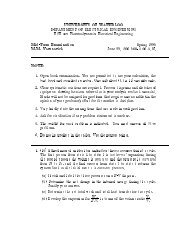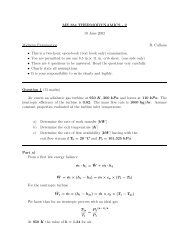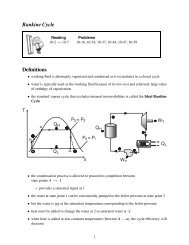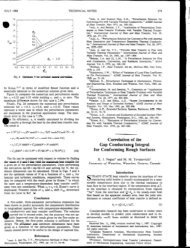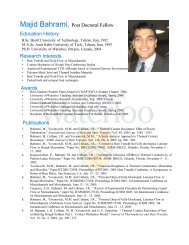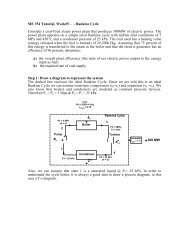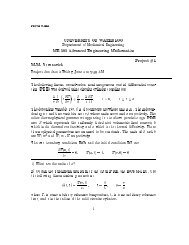Adobe PDF
Adobe PDF
Adobe PDF
You also want an ePaper? Increase the reach of your titles
YUMPU automatically turns print PDFs into web optimized ePapers that Google loves.
WKxTPCSWEB.TEX<br />
ME 303 M.M. Yovanovich<br />
Week 10<br />
Lecture 1<br />
Discussed the physics of the problem of Project 2. Used Maple to show the<br />
temperature plots as a function of dimensionless time.<br />
Solution procedure is based on the material covered in Section 4 which deals<br />
with nonhomogeneous PDEs and nonhomogeneous BCs.<br />
Last tutorial, the TAs discussed this solution procedure as applied to the heat<br />
equation with nonhomgeneous BCs. The tutorial this week will consider the<br />
solution procedure applied to the nonhomogeneous wave equation.<br />
Section 2.3 Vibrations of beams: longitudinal (axial) and transverse.<br />
Longitudinal vibrations, u(x; t):<br />
u tt = c 2 u xx ; t>0; 0
The spatial ODE becomes:<br />
X iv , m 4 X =0;<br />
0
where h is the heat transfer coecient, and T 1 is the ambient temperature. An<br />
energy balance (heat balance) at the end x = L where Q cond = Q conv gives<br />
the Robin BC: !<br />
@u(x; t)<br />
= , h @x<br />
k (u(L; t) , T 1)<br />
x=L<br />
This BC is nonhomogeneous due to T 1 . It can be made homogeneous by the<br />
introduction of (x; t) =u(x; t) , T 1 . Note that<br />
The Robin condition becomes:<br />
@<br />
@x = @u<br />
@x ; because @T 1<br />
@x =0<br />
@(x; t)<br />
@x<br />
!<br />
x=L<br />
= , h k (L)<br />
which is homogeneous.<br />
Observe that Spiegel has used the symbol h to represent the two parameters<br />
h=k. Many math texts do this. Be careful of the units.<br />
Lecture 2<br />
Alternative formulation of the problem of Section 4.5.<br />
and<br />
@ 2 <br />
@x = 1 @<br />
; t>0; 0
Since C 2 = 0 gives a trivial solution we choose<br />
cos L + h sin L =0 or cos + Bi sin =0<br />
k<br />
where = L and Bi = hL=k with 0
This is a Fourier sine series. The Fourier coecients D n can be found by means<br />
of the orthogonality property of the sines. Multipy the left-hand side and all<br />
terms of the right-hand side by sin m xdxand integrate with respect to x. Thus<br />
Z L<br />
When m 6= n wehave<br />
0<br />
otherwise when m = n ,<br />
Z L<br />
0<br />
(f(x) , T 1 ) sin m xdx=<br />
Z L<br />
0<br />
1X<br />
n=1<br />
sin m x sin n xdx=0<br />
sin 2 n xdx= nL , cos n L sin n L<br />
2 n<br />
= L 2<br />
Z L<br />
D n sin m x sin n xdx<br />
0<br />
" #<br />
n , cos n sin n<br />
n<br />
Using the relationship given by the CE, the above integral can be written as<br />
Z L<br />
and the Fourier coecients are given by<br />
D n =<br />
0<br />
sin 2 n xdx= L Bi + cos 2 n<br />
2 Bi<br />
Bi 2<br />
Bi + cos 2 n L<br />
Z L<br />
0<br />
(f(x) , T 1 ) sin n xdx<br />
To proceed further one needs to specify the function f(x).<br />
Lecture 3<br />
Similarity Method (Boltzmann Transformation)<br />
Transforms PDE into ODE.<br />
One-dimensional diusion equation:<br />
with initial condition:<br />
and boundary conditions for t>0:<br />
T xx = 1 T t; t>0; x>0<br />
T (x; 0) = T i ; x 0<br />
T (0;t)=T 0 ;<br />
T (x !1;t) ! T i<br />
5
Dene temperature excess to create homogeneous conditions: (x; t) =T (x; t),<br />
T i . The problem becomes:<br />
with initial condition:<br />
and boundary conditions for t>0:<br />
xx = 1 t; t>0; x>0<br />
(x; 0)=0; x 0<br />
(0;t)= 0 = T 0 , T i ; (x !1;t) ! 0<br />
Introduce the similarity parameter: =<br />
@<br />
@x = p 1 and @<br />
4t @t =<br />
Let () =(x; t)= 0 .<br />
Transform the partial derivatives.<br />
@<br />
@x = @<br />
@ [ 0] @<br />
@ 2 <br />
@x = @ @<br />
2 @x @x = @<br />
@<br />
@<br />
@t = @ @ ( 0 ) @<br />
@t = @ @<br />
0<br />
@ @t<br />
Substitute into the PDE and replace<br />
x p<br />
4t<br />
. Note that<br />
<br />
p x , 1 <br />
4 2 t,3=2<br />
@x = 0 @<br />
p<br />
4t @<br />
(<br />
0 @ p4t<br />
@<br />
)<br />
@<br />
@x = 0 @ 2 <br />
4t @ 2<br />
( )<br />
x<br />
<br />
p t ,1=2 = x 0<br />
p , 1 @<br />
4 4 2 t,3=2 @ =<br />
, x p 0 @<br />
2t 4t @ = , 0 @<br />
2t @<br />
@ 2 <br />
@ 2<br />
by<br />
d 2 <br />
because () only<br />
d 2<br />
@ 2 <br />
@x 2 , 1 <br />
@<br />
@t = 0 d 2 <br />
4t d + 0 d<br />
2 2t d =0<br />
Divide by 0 and multiply by 4t to get ODE:<br />
d 2 <br />
d 2 +2 d =0<br />
6
Transformed initial and boundary conditions:<br />
and<br />
t =0; = 1; =0<br />
t>0; x =0; =0; =1<br />
t>0; x !1; !1; ! 0<br />
Solution of ODE.<br />
Let w = d=d to reduce order of ODE.<br />
dw<br />
d<br />
+2w =0<br />
Apply separation of variables method to nd the solution of the ODE. Therefore,<br />
dw<br />
w = ,2d<br />
After integration we get<br />
w = d<br />
d = C 1e ,2<br />
Another integration gives<br />
Z <br />
= C 1 e ,2 d + C 2<br />
0<br />
where lower limit was arbitrarily set to zero.<br />
Apply the boundary conditions to nd the constants: C 1 ;C 2 . When =0,<br />
= 1, the integral is zero, and C 2 =1.<br />
When = 1, = 0 and we have<br />
0=C 1<br />
Z 1<br />
0<br />
e ,2 d +1=C 1<br />
p <br />
2 +1<br />
The value of the integral is p =2. The rst constant ofintegration is<br />
C 1 = , 2 p <br />
The solution of the ODE and therefore the PDE is<br />
=1, 2 p <br />
Z <br />
0<br />
e ,2 d =1, erf() =erfc()<br />
7
where erf() and erfc() are the error and complementary error functions with<br />
similarity parameter: = x=(2 p t).<br />
The solution can also be expressed as<br />
T (x; t) , T i<br />
= erfc<br />
T 0 , T i<br />
x<br />
2 p t<br />
!<br />
t>0; x 0<br />
See Maple worksheets for Similarity Method and some characteristics of the<br />
error and complementary error functions.<br />
Some properties of these important special functions:<br />
erf(0)=0; erf(1) =1; erf(,) =,erf(); erfc() =1, erf()<br />
8


